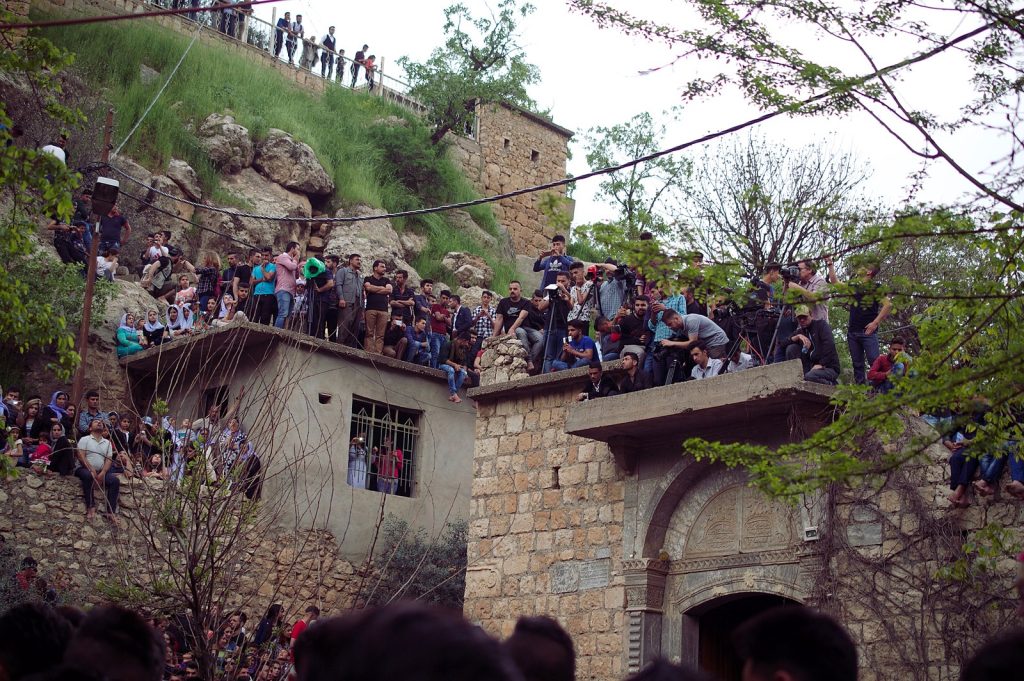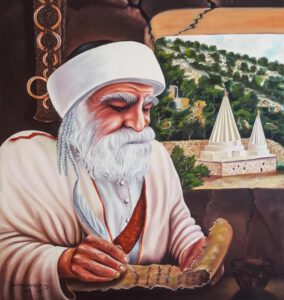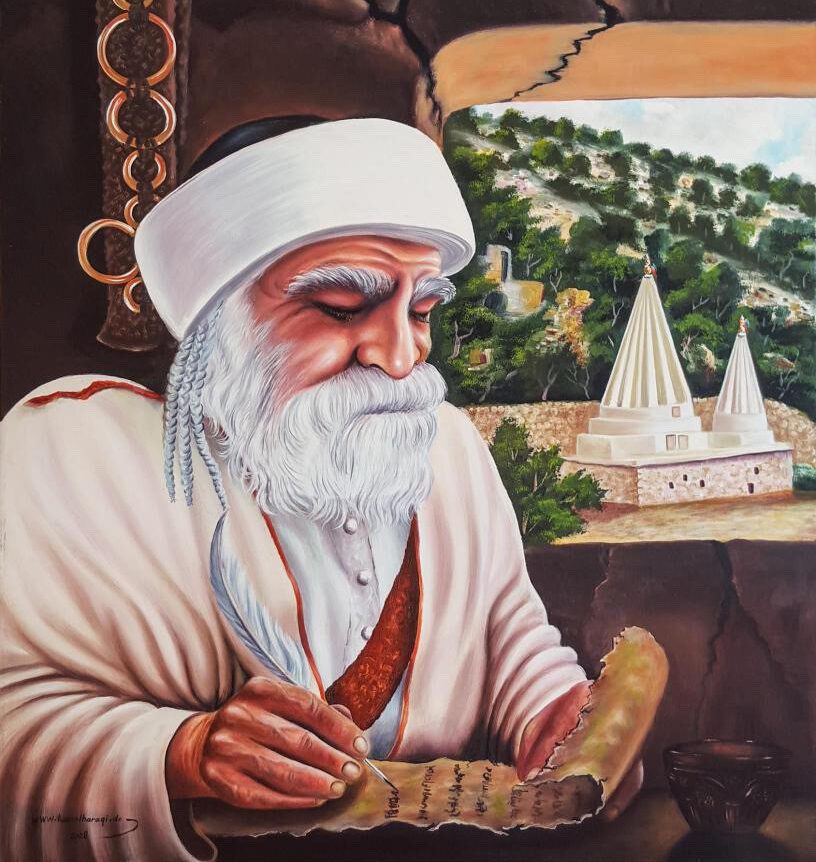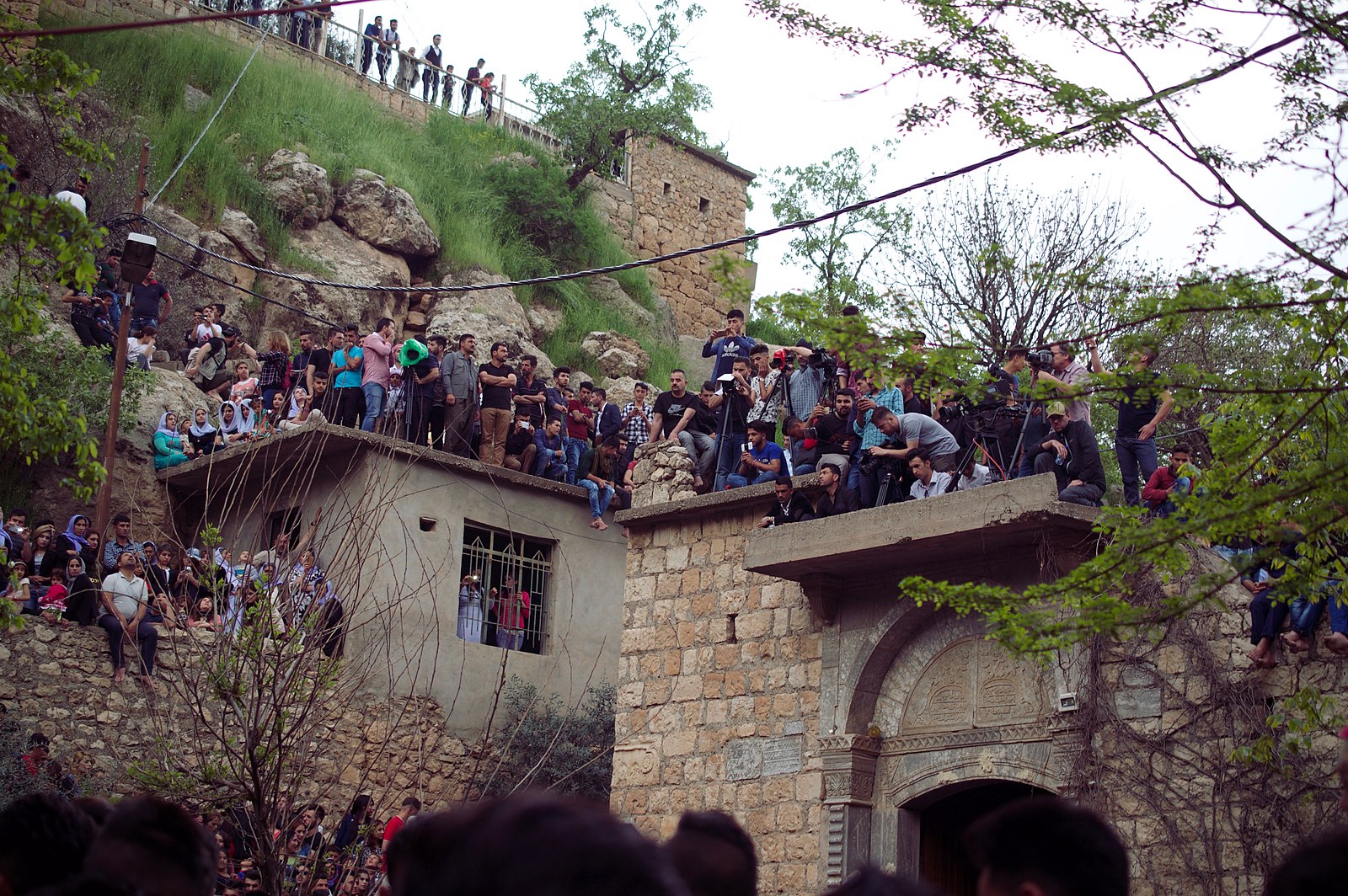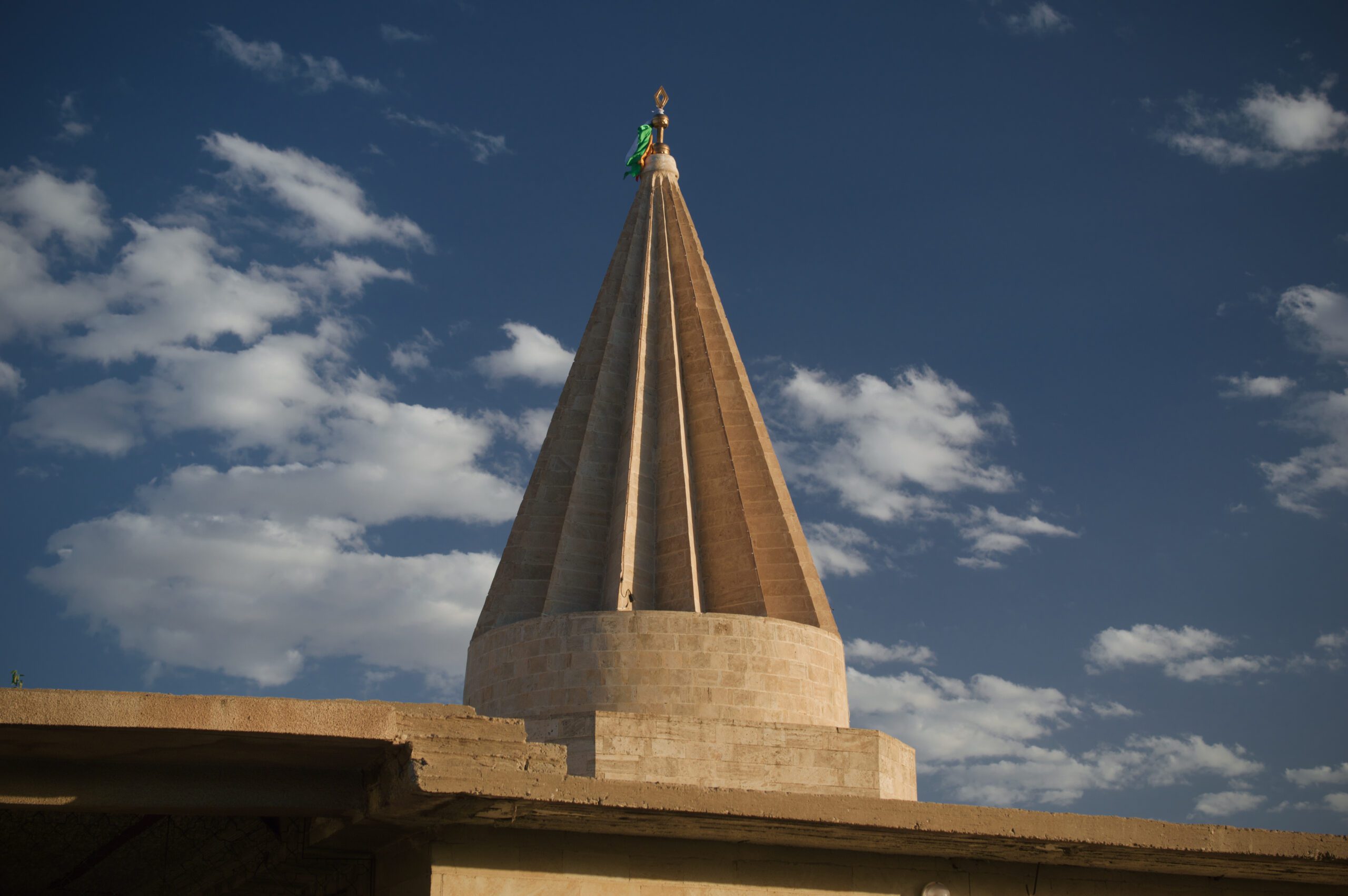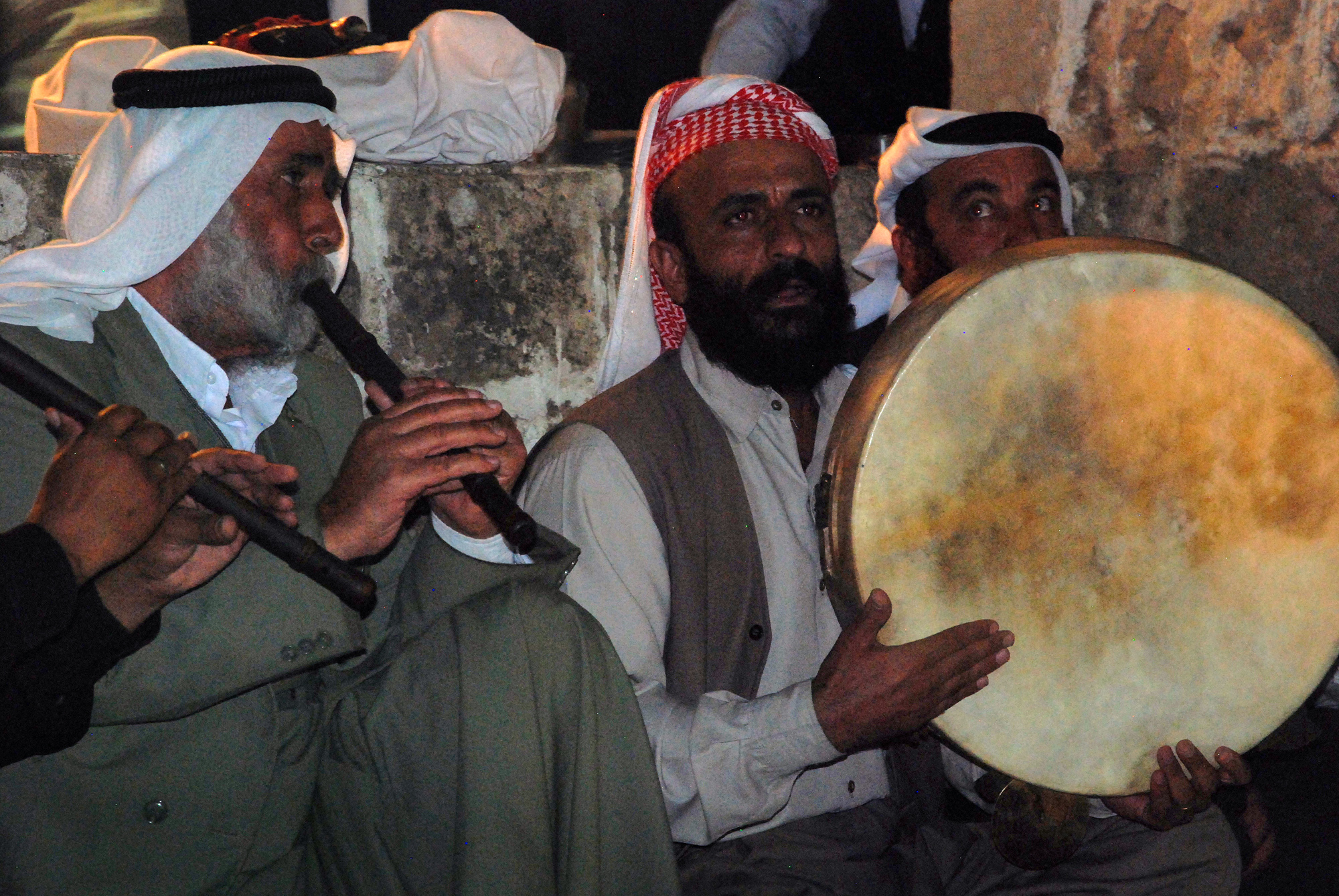Introduction
Ezidi community is organized in a caste system, which comprises of three castes. Two of them being priestly castes, namely the Şêx caste (Kurdish: “Çîna Şêxa”, “Şêxanî”, “Şêxîtî”) and the Pîr caste (Kurdish: “Çîna Pîra”, “Pîranî”). These two castes are categorized as Dunav (lit. “The Two-Named”), Ruhanî (lit. “spiritual”, “clerical”), Terîq (lit. “Path”) and Mala Adiya (lit. “House of Adî”) among Ezidis and are divided into clans and sacred lineages (Kurdish: “ocax”, “binemal”) directly descending from some Ezidi holy figures (Kurdish: “Xudan”, “Xas”, “Babçak”), mostly saints who lived in 12th-13th century, a period referred to as the “Era of the Saints” (Kurdish: “Zemanê Xasa”). The third and largest caste, which composes the majority of all Ezidis, is the Mirîd caste (Kurdish: “Çîna Mirîda”, “Mirîdxane”), classified as Êknav/Yeknav (lit. “The One-Named”) among Ezidis.[1]Xanna Omerxalî, 2011, “Êzdiyatî: Civak, Sembol, Rîtûel û Mît” p. 35[2]Omarkhali, Khanna. The Yezidi Religious Textual Tradition, from Oral to Written: Categories, Transmission, Scripturalisation, and Canonisation of the Yezidi Oral Religious Texts: With Samples of Oral … Continue reading[3]Dîma, Pîr. Êzdîyên Serhedê: Sedsala XIX – Destpêka XX. Translated by Ezîzê Cewo, Weşanxaneya Do, 2011. pp. 36-38[4]Pirbari, Dimtri, 2008, Lalişa Nûranî, p. 12-16 It is strictly forbidden for these castes to intermarry as per the Şerbikê Zêrîn (lit. “The Golden Cup”) law, which is one of the three fundamental prohibitions in Ezidism (“Sê Herf”). Breaking Sê Herf leads to immediate excommunication from the Ezidi community. It is believed that inter-caste marriage is comparable to sibling marriage, as the bond between an Ezidi and the person who can carry out rites of passage and initiation for them is spiritually equivalent to that of a brotherly or sisterly bond, thus making it a sin for their families to intermarry.[5]Ibid. p. 12[6]”Why are Yazidis not allowed to marry within the community to members of a caste other than their own?” – Answers to questions about Ezidism, official website of the Spiritual … Continue reading
It is important to note that in Ezidi society, the roles of the castes are mainly tied to religious duties and roles, and a person’s social or economic status is not determined by their caste. There is no segregation between the three castes; instead, they regularly interact with one another without restrictions, and all Ezidis, regardless of caste, have the ability to achieve prominent priestly, economic, political or administrative positions within their communities.[7]Although she also makes the presumption of Ezidis having “lower” and “higher” castes, Allison testifies to seeing instances of some Mirîds becoming financially successful and … Continue reading[8]Pîr Dîma, 2011, p. 35[9]Dimitri Pirbari, 2008, p. 16
As per the Pênc Ferzên Heqîqetê (“Five Obligations of Truth”), each Ezidi must have their own Şêx, Pîr, Merebî (“Spiritual Mentor”), Hosta (“Spiritual Teacher”) and Birayê/Xuşka Axiretê (“Brother/Sister of the Hereafter”).[10]نذیر سەرگەلی (٢٠٢١) ئێزدیاتی: ل بەر روناهیا قەول سەبەقا (Nedîr Sergelî, 2021, Êzdiyatî: Li Ber Ronahîya Qewl û Sebeqa), p. 12[11]Xanna Omerxalî, 2011, pp. 55, 80, 136 For an Ezidi, who their Şêx and Pîr is, is typically determined by the family, clan or tribe they belong to. For example, Ezidis of the Hewêrî tribe are Mirîds of Şêx Mend, who is the tribe’s patron Xudan, and as such, their Şêxs also usually hail from the Şêx Mend lineage (“Şêxên Şêx Menda”).[12]Pîr Dîma, 2011, pp. 34, 36
These obligations apply not only to Mirîds alone but even to those belonging to the Şêx and Pîr castes. That is, each Şêx must also have their own Şêx and Pîr, and likewise, every Pîr must have a Şêx and Pîr of their own. So these castes do not have the duty of being a Şêx or Pîr to their Mirîds alone, but also of being a Mirîd (“follower”, “disciple”) to their own respective Şêxs and Pîrs. Hence the classification “Dunav” (lit. “Two-Named”) referring to their two duties, in contrast to the term “Êknav” (lit. “One-Named”) applied to Mirîds, who have the duty of being a Mirîd to their Şêx and Pîr.[13]Ibid. pp. 33-34
Şêx

Derived from the Arabic word “shaykh” or “sheikh” (شيخ), meaning “elder”, “old man” or “leader”, members of the Şêx caste among the Ezidis are responsible for religious and administrative duties. Other than the task of counselling their Mirîds spiritually, attending to their religious life, guiding them on the right path and being mediators to disputes or issues that arise within the family, they also have the exclusive permission to carrying out certain Ezidi rites of passages and initiation. These include:[15]Ibid. pp. 32-37[16]Dimitri Pirbari, 2008, p. 16
- Biskhildan (lit. “Cutting of the Lock”) in which the Şêxê Biskê (lit. “Şêx of the Lock”) cuts a lock of hair from the infant child of his Mirîd.
- Mehrbirîn (lit. “to wed”), in which a Şêx of Melik Şêxisin lineage (Adanî clan) officiates a wedding and registers the marriage.
- Carrying out funerary rites such Şûştina Mirîyan (lit. “The Washing of the Dead) and Veşartina Mirîyan (lit. “The Burial of the Dead”), during which the Şêx washes the deceased’s body and carries out the necessary rituals and ceremonies to prepare the body for burial. The Pîr may also participate in these rites.
- Being present at the circumcision (Kurdish: “Sunetkirin”) of a child.
- Being chosen as Birayê/Xuşka Axiretê (lit. “Brother/Sister of the Hereafter”), which is mandatory for every Ezidi. Only Şêxs and Pîrs are allowed to be chosen for this role.
A Şêx’s service may also be sought sometimes for treating illnesses and ailments or handling animals associated with their Xudan. As examples, Şêxs of Amadîn lineage have the power to cure stomach pain and Şêxs of Şêx Mend lineage have the power to tame snakes and heal their bites. In return for these religious services, the Şêx receives a fee, donation or alms from the Mirîd referred to as Fito (unclear etymology, although it can also be translated as “tax” or “donation”), Zikat (lit. “tax”), Xêrat (lit. “alm”, “donation”) or Rism (lit. “rate”, “levy”). For Şêxs, there is no fixed amount for how high this fee must be, and is usually dependent on the economical situation of the Mirîds. Sometimes, an animal may be sacrificed and it will get accepted as “Xêrat” by the Şêx.[17]Pîr Dîma, 2011, p. 35
The Şêxs are divided into three endogamous clans, each further divided into multiple lineages and sublineages. In Ezidi theology, the ancestors of the Şêxs are believed to be earthly manifestations of the seven angels, who incarnated on earth in the 13th century. Since these three clans share a spiritual bond through being each other’s Şêxs and Merebîs, marriage between them is forbidden.[18]Ibid. p. 35
The clans and their respective ancestors are as follows:
Şemsanî: See more here
Adanî: Named after Şîxadî (Şêx Adî ibn Misafir) and descended from his brother, the progenitor of this clan is Melik Şêxisin (Şêx Hesen ibn Şêx Adî II ibn Sexr Ebû’l Berekat), the great-grandnephew of Şîxadî. Şêxisin had 5 sons and 3 daughters, among whom some Adanî sublineages are named after:[19]Ibid. pp. 43-44[20]Dimitri Pirbari, 2008, p. 14
- Şêx Birahîmê Xetmî, whose descendants today represent the Melik Şêxisin lineage (“Şêxên Melik Şêxisina”)
- Şerfedîn
- Şêx Zeydîn / Şêx Zêndîn
- Şêx Mûsê Sor
- Şêx Êtîm
- Sitîya Tawis
- Sitîya Nefîs
- Sitîya Hebîb[21]Her name is left out from Adanî family trees presented in literature, however, thanks to information provided to us by Şêx Mişûr, a Micêwir of the village of Sirêçka, we found out Melik … Continue reading
Qatanî: Named after the eponymous progenitor of this clan, Derwêş Qatan.[22]Pîr Dîma, 2011, p. 44 The ancestors of this clan came from a long line of ascetics referred to as “Derwêş” in Ezidism, who were as follows:[23]Bedelê Feqîr Hecî. Lalişname: Lêkolîn – Têkist – Gotar, 2019, p. 66
- Derwêş Redwan
- Derwêş Çirkîn
- Derwêş Mistehîn
- Derwêş Hebîb
- Derwêş Gorgîn
- Derwêş Qatan
- Derwêş Adem
In tradition, Derwêş Adem is recorded to have gone to Xorîstan and married the daughter of the prince of Xorîstan (“Mîrê Xorîstanê”). From this marriage, Mîr Birahîmê Adem was born.[24]Ibid. pp. 132-144 Today, the Qatanî lineages are named after his offspring, who are as follows:[25]Pîr Dîma, 2011, pp. 44-45
- Şêxûbekir, under whose branch three sublineages are found, namely Sorê Sora, Ker û Lala and Mawiyê Zer.
- Şêx Ebdilqadirê Rehmanî
- Şêx Simayilê Enzelî
Among the Qatanî, there is also a subclan referred to as the Pismîr (lit. “The Princely Offspring”). The Pismîrs hail from two lines of descent through two sons of Şêx Mehmedê Batinî, a 14th-century Ezidi figure who was a descendant of Mîr Birahîm. One is through the line of Mîr Melek, whose descendants make up the ruling Mîr family and are thus in charge of the title of Mîrê Şêxan (“Prince of Şêxan”) or Mîrê Êzîdxanê (“Prince of Êzîdxan”), who rules over the Ezidi community as its highest authority and representative, and the other line of descent is through Mîr Mensûr, whose descendants make up the rest of the Pismîr subclan.[26]For more about the Ezidi Mîrs, see: Mossaki, Nodar & Pirbari, Dimitri. (2019). The death of Mir Tahsin Beg and the future of the Yezidi community. Asia and Africa Today. … Continue reading[27]Dimitri Pirbari, 2008, p. 205
Şêxs are in charge of the vast majority of the leading religious titles within the central clergy, including:[28]Ibid. pp. 204-205[29]سیدو ختو حسو (٢٠٢١) شرۆڤەکرنا هندەک رێ ورەسم وتێکستێن ئۆلا ئێزدیان (Sîdo Xeto Heso, 2021, Şirovekirina Hindek Rê û Resm û Têkistên Ola … Continue reading
- Extiyarê Mergehê (lit. Elder of the Mergeh[30]Mergeh is another name for the Laliş valley.), also known as Babê Şêx, under the charge of Şêxs of Fexredîn lineage (Şemsanî clan).
- Pêşîmam, with Şêxs of Melik Şêxisin lineage being in charge of “Pêşîmamê Mergehê” title and Şêxs of Şerfedîn lineage in charge of “Pêşîmamê Babê Şêx” title (Adanî clan).
- Babê Gavan, which is under the charge of Şêxs of Amadîn lineage (Şemsanî clan).
- Şêxê Wezîr, which is under the charge of Şêxs of Şêx Şems (Şêşims) lineage (Şemsanî clan).
Pîr

The term “pîr” is of Iranic root and has the same meaning in Kurdish as “Şêx” in Arabic (“elder”, “old man”). Pîrs are the least numerous of the three castes and their roles and duties are similar to those of Şêxs, however, in contrast to Şêxs, they are in charge of purely religious functions and do not possess any exclusive right and authority over leading titles and positions within the central clergy.[32]Pîr Dîma, 2011, p. 37[33]Pirbari, Dimitri, Mossaki, Nodar, & Yezdin, Mirza Sileman. (2020). A Yezidi Manuscript:—Mišūr of P’īr Sīnī Bahrī/P’īr Sīnī Dārānī, its study and critical analysis. Iranian … Continue reading
Per Ezidi tradition, Pîrs should visit their Mirîds on an annual basis, usually in the spring season, to counsel them, attend to their religious life and guide them on the right path, bless their hearths and perform the “Du’aya Zikatê” prayer over their bread and salt. In return, they receive offerings from their Mirîds through the form of “Fito” or “Zikat” as well as as sacrificial animals, usually lambs. According to tradition, the Pîr must be given one-tenth of annual income, some of which the Pîr keeps for the needs of his family, while distributing the rest among the needy and poor Ezidis.[34]Ibid Like Şêxs, Pîrs are also sought for treatment of illnesses and handling of animals, as each Pîr lineage has a special power to treat different ailments and tame different animals. For instance, Pîrs of Pîrê Cerwa lineage have the ability to tame scorpions and are sought for curing scorpion stings and carrying out rituals to protect a house against scorpion infestation.[35]Aysif, Rezan Shivan, 2021, “The Role of Nature in Yezidism: Poetic Texts and Living Tradition” pp. 243-244
Pîrs are also divided into sacred lineages descending from Ezidi holy figures. The founders of the bulk of these lineages were among the forty companions of Şîxadî, known as “Çilê Şîxadî”, and the forty companions of Melik Şêxisin, referred to as “Çilê Melik Şêxisin”, who are venerated in Ezidism today as saints and referred to as Pîrs. It is worth noting that some lineages are named after the parents or descendants of these companions instead, and some are named after saints that were unrelated to either group of companions. Some saints, including for example Pîr Hemedê Boz, did not leave any offspring and thus lack lineages named after them.[36]Pirbari, Dimitri, & Mossaki, Nodar. (2022). A Yezidi Manuscript – Mišūr of Pir Amar Qubaysi, its study and critical analysis, https://doi.org/10.26907/2619-1261.2022.5.3.66-87
Generally, there are no restrictions on marriage between the Pîr lineages. Pîrs may marry any lineage except for the lineages that are their Mirîds, Merebîs and Pîrs. Marriage with the lineage descended from a family member of their Pîr is also forbidden. For example, Pîr of the Pîr Omerxala lineage is Pîr Hecî Mehmed, and since Pîrs of Pîrê Cerwa descend from Pîr Hecî Mehmed’s brother, Pîrs of Pîr Omerxala lineage are forbidden from marrying Pîrs of both Pîrê Cerwa and Pîr Hecî Mehmed lineages.[37]Ibid[38]Pîr Dîma, 2011, pp. 37, 51
To date, no trustworthy and standardized list of all Pîr lineages has been published. However, based on the data gathered from various sources, we found mentions of the following Pîr lineages, excluding those whose existence could verifiably be ruled out:[39]Ibid. pp. 51-61[40]Pirbari, Dimitri. Mossaki, Nodar. & Yezdin, Mirza Sileman. 2020[41]Pirbari, Dimitri, & Mossaki, Nodar. 2022[42]Pirbari, Dimitri, & Mossaki, Nodar, (2022). A Yezidi Manuscript – Mišūr of P’īr ‘Omar Khālān, its Syudy and Critical Analysis. The Near East and Georgia, No. 14, … Continue reading[43]Sîdo Xeto Heso, 2021, pp. 21-22[44]Omarkhali, Khanna, 2017, pp. 567-568[45]داود مراد ختاري. (2024, July 13). مشورات ابيار الإيزيدية “دراسة تحليلية” الحلقة الاولى. Bahzani.net. Retrieved September 21, 2024, from … Continue reading
- Hesin Pîrik (extinct)
- Pîr Adî
- Pîr Afat
- Pîr Al, Pîrê Al, Pîr Alî, Pîrê Alî, Piyal
- Pîr Alûbekir
- Pîr Axa
- Pîr Bad, Pîrê Bad, Pîrebad
- Pîr Bak
- Pîr Bakoz
- Pîr Bazîd
- Pîr Bedew
- Pîr Beybûn
- Pîr Biwal
- Pîr Boz, Bûz
- Pîr Bûb, Bû
- Pîr Bûk, Pîrê Binûk
- Pîr Cerwan, Pîrê Cerwa
- Pîr Çilmêra
- Pîr Dawidê bin Derman
- Pîr Delî
- Pîr Dir Cinan
- Pîr Dirbês
- Pîr Ebdilrehman
- Pîr Ebrahîm
- Pîr Edrîs
- Pîr Eyûb
- Pîr Êzîd, Êzî
- Pîr Fadil
- Pîr Gavanê Zerza
- Pîr Germ
- Pîr Haciyal, Hacalî
- Pîr Hacxal
- Pîr Hecî Elî
- Pîr Hecî Mehmed
- Pîr Hekîm
- Pîr Helan
- Pîr Hemalî
- Pîr Hemedê Babê
- Pîr Hemis
- Pîr Herher
- Pîr Hesen
- Pîr Hesin Çikêr
- Pîr Hesin Çinarî
- Pîr Hesin Deqîq
- Pîr Hesin Elka (Hesnelka), Hesnelekan, Heslenak
- Pîr Hesin Meman, Hesmeman, Hesil Meman (Pîrê Çil Pîra)
- Pîr Hesin Şirîn
- Pîr Hesin Telkê (Hesentelkê), Hesin Telik
- Pîr Hêsim
- Pîr Hinan, Henan
- Pîr Hû
- Pîr Îs
- Pîr Îsêbiya, Êsîbiya
- Pîr Îshaqê Kurdî
- Pîr Îsmaîl el-Tunîsî
- Pîr Kar, Kal
- Pîr Kaûs
- Pîr Kevanî Rût
- Pîr Lexer
- Pîr Lûfî
- Pîr Mecirmafa
- Pîr Mehed Yeşan
- Pîr Mehmed Reşan
- Pîr Mehmedî Reben
- Pîr Mehmûd, Mehbûb
- Pîr Melîha
- Pîr Memê Şivan, Mamşivan
- Pîr Men
- Pîr Mend
- Pîr Mensûr
- Pîr Merqebês, Emer Qubeysî, Emer Qebîs, Emer Qapçî, Meqlevêz
- Pîr Merwan
- Pîr Meyisûr
- Pîr Momin
- Pîr Mûs
- Pîr Nêçîrvan
- Pîr Nûh
- Pîr Omerxala (Omer Xalan)
- Pîr Qa’îd
- Pîr Qedîbilban
- Pîr Qedmanî
- Pîr Qemer
- Pîr Reşkar
- Pîr Riwal
- Pîr Rusî
- Pîr Sedîq
- Pîr Sefer
- Pîr Sêvdî Cinêt
- Pîr Silêman
- Pîr Sînanezar
- Pîr Sînî Behrî, Pîrê Behrî
- Pîr Şems, Şemsê Pîra
- Pîr Tokil
- Pîr Tûs, Tûz
- Pîr Xemsî
- Pîr Xetî Pisî
- Pîr Xidir Liyas
- Pîr Xoşava, Pîrikê Xoşavayî
- Pîr Zekir
- Pîrê Atqatê
- Pîrê Balûk
- Pîrê Batin (Pîr Tawûsî Pîr?)
- Pîrê Çak
- Pîrê Çêlê
- Pîrê Deve
- Pîrê Evdiya
- Pîrê Ewra
- Pîrê Gerger
- Pîrê Kemala, Pîr Kemal
- Pîrê Kewkî
- Pîrê Libnan, Libna
- Pîrê Mala Bala
- Pîrê Navdar
- Pîrê Nerm
- Pîrê Qelender
- Pîrê Qerecerî
- Pîrê Qerqûr
- Pîrê Qilêç
- Pîrê Sibatê
- Pîrê Sinîbalê
- Pîrê Sînexalî
- Pîrê Şaliyar
- Pîrê Şamiya
- Pîrê Terciman
- Pîrê Tûskî
- Pîrê Xanî (Pîrê Xana Êzdî)
- Pîrê Xefûf
- Pîrê Xinûq
- Pîrê Zozanî
Mirîd
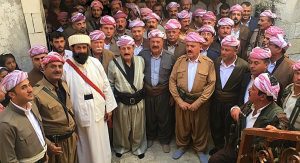
Derived from the Arabic word “murid” (مريد), meaning “disciple” or “follower”, the term Mirîd refers to Ezidis who are not from spiritual lineages linked to saints. Often described as the “lay caste”, Mirîds are the most numerous of the three Ezidi castes and are organized into tribes (Kurdish: “êl”, “eşîr/eşîret”, “hoz”, “berek”, “qebîl”).[47]Omarkhali, Khanna. (2008). On the Structure of the Yezidi Clan and Tribal System and its Terminology among the Yezidis of the Caucasus. Journal of Kurdish Studies, 6(0), 104–119. … Continue reading[48]Pîr Dîma, 2011, p. 38 For a list of all Ezidi tribes, see here.
Contrary to some misconceptions, they are not considered a “lower” or “inferior” caste. Although they do not have the privilege to carry out some rites of initiation and passage or to attain certain religious positions, Mirîds have no less opportunities to gain prominent positions in society, religion, administration and economy than Şêxs and Pîrs. Mirîds are known historically as well as today to occupy aristocratic titles like village chief (Kurdish: “muxtar”) or tribal chief (Kurdish: “axa”, “beg”),[49]See for example the Axalerî, a Mirîd tribe of aristocratic descent, and Cangîr Axa and Usuv Beg famous Ezidi chiefs of Mirîd caste (Ibid. pp. 74, 108-109, 123, 134, 145 as well as prominent religious titles like Micêwir/Serderî (shrine custodian), Feqîr (an ascetic priest trained in religious knowledge), Koçek (seer, oracle, shaman), Qewlbêj (reciter and expert of Qewls), and Ilmdar/Zana (religious scholar), just like their Şêx and Pîr counterparts.[50]Ibid. pp. 32, 41
Since Mirîd translates to “follower” or “disciple”, every Ezidi can in a way be described as Mirîd, regardless of tribe, lineage or caste, as it is obligatory for every Ezidi to have a Şêx and Pîr of their own. Furthermore, by adhering to their religion, every Ezidi is ultimately a Mirîd of Şîxadî (“Mirîdên Şîxadî”).[51]Ibid. pp. 33-34
References[+]
| ↑1 | Xanna Omerxalî, 2011, “Êzdiyatî: Civak, Sembol, Rîtûel û Mît” p. 35 |
|---|---|
| ↑2 | Omarkhali, Khanna. The Yezidi Religious Textual Tradition, from Oral to Written: Categories, Transmission, Scripturalisation, and Canonisation of the Yezidi Oral Religious Texts: With Samples of Oral and Written Religious Texts and with Audio and Video Samples on CD-ROM. Harrassowitz Verlag, 2017. p. 27 |
| ↑3 | Dîma, Pîr. Êzdîyên Serhedê: Sedsala XIX – Destpêka XX. Translated by Ezîzê Cewo, Weşanxaneya Do, 2011. pp. 36-38 |
| ↑4 | Pirbari, Dimtri, 2008, Lalişa Nûranî, p. 12-16 |
| ↑5 | Ibid. p. 12 |
| ↑6 | ”Why are Yazidis not allowed to marry within the community to members of a caste other than their own?” – Answers to questions about Ezidism, official website of the Spiritual Council of Ezidis in Georgia (Atqat.com) Retrieved July 18, 2024, from http://atqat.com/faq/0-0-70 |
| ↑7 | Although she also makes the presumption of Ezidis having “lower” and “higher” castes, Allison testifies to seeing instances of some Mirîds becoming financially successful and prosperous, while some Şêxs lived in poverty, during her field research in 1992, which challenges the notion of the Ezidi caste system being class-based. See: Allison, Christine. Yezidi Oral Tradition. Routledge, 2001. pp. 30-31 |
| ↑8 | Pîr Dîma, 2011, p. 35 |
| ↑9 | Dimitri Pirbari, 2008, p. 16 |
| ↑10 | نذیر سەرگەلی (٢٠٢١) ئێزدیاتی: ل بەر روناهیا قەول سەبەقا (Nedîr Sergelî, 2021, Êzdiyatî: Li Ber Ronahîya Qewl û Sebeqa), p. 12 |
| ↑11 | Xanna Omerxalî, 2011, pp. 55, 80, 136 |
| ↑12 | Pîr Dîma, 2011, pp. 34, 36 |
| ↑13 | Ibid. pp. 33-34 |
| ↑14 | Attribution: Levi Clancy, CC0, via Wikimedia Commons |
| ↑15 | Ibid. pp. 32-37 |
| ↑16 | Dimitri Pirbari, 2008, p. 16 |
| ↑17 | Pîr Dîma, 2011, p. 35 |
| ↑18 | Ibid. p. 35 |
| ↑19 | Ibid. pp. 43-44 |
| ↑20 | Dimitri Pirbari, 2008, p. 14 |
| ↑21 | Her name is left out from Adanî family trees presented in literature, however, thanks to information provided to us by Şêx Mişûr, a Micêwir of the village of Sirêçka, we found out Melik Şêxisin had a third daughter, Sitîya Hebîb, who is also Nasirdîn’s wife. |
| ↑22 | Pîr Dîma, 2011, p. 44 |
| ↑23 | Bedelê Feqîr Hecî. Lalişname: Lêkolîn – Têkist – Gotar, 2019, p. 66 |
| ↑24 | Ibid. pp. 132-144 |
| ↑25 | Pîr Dîma, 2011, pp. 44-45 |
| ↑26 | For more about the Ezidi Mîrs, see: Mossaki, Nodar & Pirbari, Dimitri. (2019). The death of Mir Tahsin Beg and the future of the Yezidi community. Asia and Africa Today. https://doi.org/10.31857/s032150750007023-7 |
| ↑27 | Dimitri Pirbari, 2008, p. 205 |
| ↑28 | Ibid. pp. 204-205 |
| ↑29 | سیدو ختو حسو (٢٠٢١) شرۆڤەکرنا هندەک رێ ورەسم وتێکستێن ئۆلا ئێزدیان (Sîdo Xeto Heso, 2021, Şirovekirina Hindek Rê û Resm û Têkistên Ola Êzdiyan) p. 25-26 |
| ↑30 | Mergeh is another name for the Laliş valley. |
| ↑31 | Attribution: Levi Clancy, CC0, via Wikimedia Commons |
| ↑32 | Pîr Dîma, 2011, p. 37 |
| ↑33 | Pirbari, Dimitri, Mossaki, Nodar, & Yezdin, Mirza Sileman. (2020). A Yezidi Manuscript:—Mišūr of P’īr Sīnī Bahrī/P’īr Sīnī Dārānī, its study and critical analysis. Iranian Studies, 53(1–2), 223–257. https://doi.org/10.1080/00210862.2019.1669118 |
| ↑34 | Ibid |
| ↑35 | Aysif, Rezan Shivan, 2021, “The Role of Nature in Yezidism: Poetic Texts and Living Tradition” pp. 243-244 |
| ↑36 | Pirbari, Dimitri, & Mossaki, Nodar. (2022). A Yezidi Manuscript – Mišūr of Pir Amar Qubaysi, its study and critical analysis, https://doi.org/10.26907/2619-1261.2022.5.3.66-87 |
| ↑37 | Ibid |
| ↑38 | Pîr Dîma, 2011, pp. 37, 51 |
| ↑39 | Ibid. pp. 51-61 |
| ↑40 | Pirbari, Dimitri. Mossaki, Nodar. & Yezdin, Mirza Sileman. 2020 |
| ↑41 | Pirbari, Dimitri, & Mossaki, Nodar. 2022 |
| ↑42 | Pirbari, Dimitri, & Mossaki, Nodar, (2022). A Yezidi Manuscript – Mišūr of P’īr ‘Omar Khālān, its Syudy and Critical Analysis. The Near East and Georgia, No. 14, (https://doi.org/10.32859/neg.14.631.302-316). p. 4 |
| ↑43 | Sîdo Xeto Heso, 2021, pp. 21-22 |
| ↑44 | Omarkhali, Khanna, 2017, pp. 567-568 |
| ↑45 | داود مراد ختاري. (2024, July 13). مشورات ابيار الإيزيدية “دراسة تحليلية” الحلقة الاولى. Bahzani.net. Retrieved September 21, 2024, from https://www.bahzani.net/?p=140007 |
| ↑46 | Attribution: @qaidy.family on Instagram |
| ↑47 | Omarkhali, Khanna. (2008). On the Structure of the Yezidi Clan and Tribal System and its Terminology among the Yezidis of the Caucasus. Journal of Kurdish Studies, 6(0), 104–119. https://doi.org/10.2143/jks.6.0.2038092 |
| ↑48 | Pîr Dîma, 2011, p. 38 |
| ↑49 | See for example the Axalerî, a Mirîd tribe of aristocratic descent, and Cangîr Axa and Usuv Beg famous Ezidi chiefs of Mirîd caste (Ibid. pp. 74, 108-109, 123, 134, 145 |
| ↑50 | Ibid. pp. 32, 41 |
| ↑51 | Ibid. pp. 33-34 |
